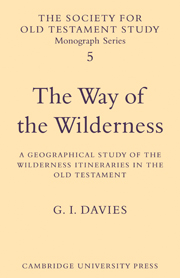Book contents
- Frontmatter
- Contents
- Preface
- Abbreviations
- Maps
- 1 Introduction
- 2 Jewish interpretations in Greek
- 3 Jewish interpretations in Hebrew and Aramaic
- 4 Christian interpretations
- 5 Arabic interpretations
- 6 Behind the traditions
- 7 Key points on the routes
- 8 Routes in the Sinai Peninsula
- 9 Identification of the routes described
- Notes to the text
- Bibliography and Author Index
- Indexes
2 - Jewish interpretations in Greek
Published online by Cambridge University Press: 04 August 2010
- Frontmatter
- Contents
- Preface
- Abbreviations
- Maps
- 1 Introduction
- 2 Jewish interpretations in Greek
- 3 Jewish interpretations in Hebrew and Aramaic
- 4 Christian interpretations
- 5 Arabic interpretations
- 6 Behind the traditions
- 7 Key points on the routes
- 8 Routes in the Sinai Peninsula
- 9 Identification of the routes described
- Notes to the text
- Bibliography and Author Index
- Indexes
Summary
The Jewish material may for convenience be divided into two parts according to the language in which it was written: Greek in the one case, Hebrew or Aramaic in the other. An important corollary of this linguistic division is the use by the one group of Greek versions of the Old Testament, while the other group works primarily from the Hebrew text. The division according to language also corresponds to a chronological division, as the Greek material dates chiefly from before 100 AD, while the Hebrew and Aramaic texts are later, although they may contain traditions which originated before this date. Although we adopt this division of the material, we do not imply that there is no contact between the two groups of texts. In fact our study confirms that at certain points there is indeed contact between them.
THE SEPTUAGINT
Only occasionally does the LXX itself indicate the direction in which the Israelites were thought to have gone. Most of the Hebrew names are simply transliterated or (occasionally) translated, and variations from MT can be explained by textual corruption in either the Hebrew or the Greek stage of transmission. It is possible that in some cases the LXX preserves the names more accurately than does MT. At one point (Num. 33: 36) the fuller text of most LXX witnesses must be attributed to a secondary harmonisation of the passage to make it agree with a statement earlier in the narrative (Num. 13: 26 (LXX v. 27)).
- Type
- Chapter
- Information
- The Way of the WildernessA Geographical Study of the Wilderness Itineraries in the Old Testament, pp. 4 - 13Publisher: Cambridge University PressPrint publication year: 1979



